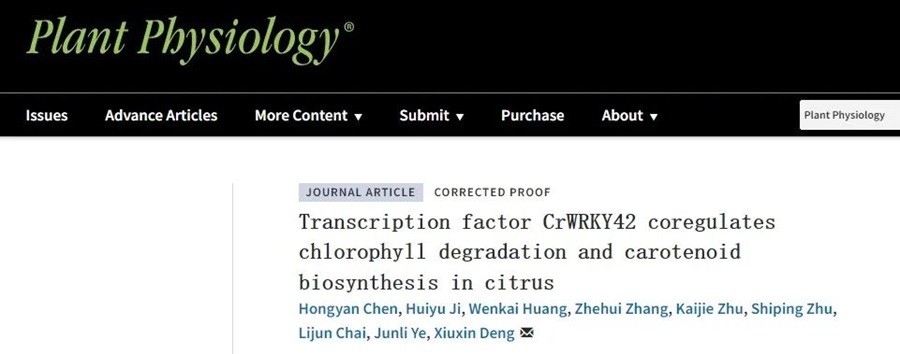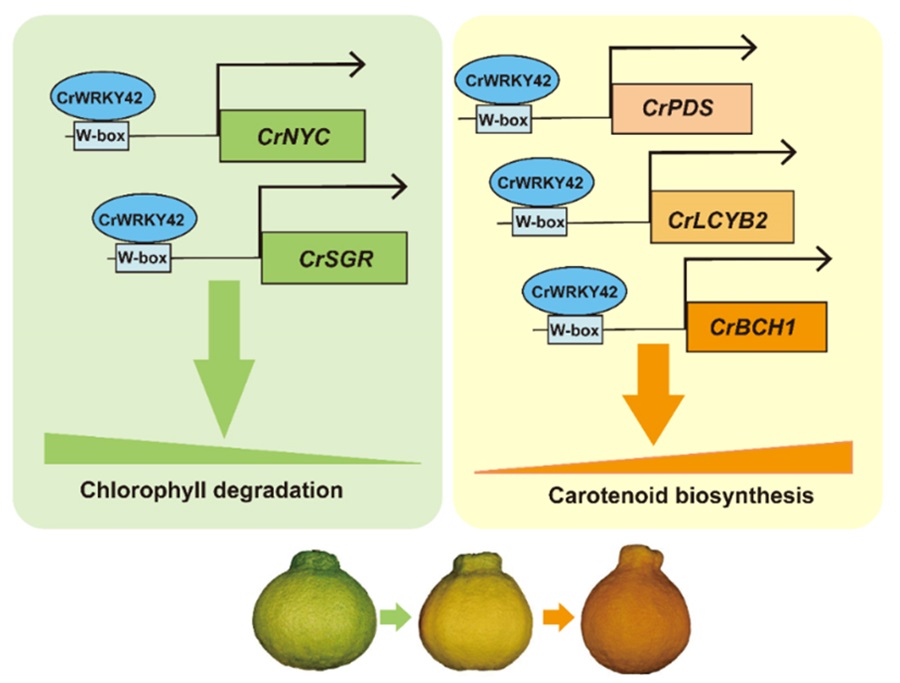近日,华中农业大学园艺林学学院/果蔬园艺作物种质创新与利用全国重点实验室邓秀新院士团队在Plant Physiology在线发表了题为“Transcription factor CrWRKY42 coregulates chlorophyll degradation and carotenoid biosynthesis in citrus”的研究论文。该研究解析了转录因子CrWRKY42通过协同调控叶绿素降解和类胡萝卜素生物合成途径促进柑橘果实着色的分子机制,该研究结果为柑橘果实色泽品质遗传改良提供了理论依据和重要基因资源。

柑橘是世界上最重要的果树之一,具有巨大的产业和经济价值。近年来我国柑橘产业快速发展,种植面积和产量均居世界首位,产量占到世界的1/3左右。色泽是柑橘果实的重要品质之一,叶绿素和类胡萝卜素组成及含量决定了其外观色泽。叶绿素降解和类胡萝卜素生物合成两条代谢途径十分复杂,受多基因多节点多因素调控。在柑橘果实成熟过程中,叶绿素降解和类胡萝卜素生物合成几乎同时发生,然而这两个代谢过程在转录水平上的协同调控尚不完全明晰。
本研究以"不知火"及其黄色果实突变体"金乐柑"为材料挖掘到一个WRKY家族转录因子CrWRKY42参与柑橘果实转色进程。在柑橘愈伤组织中超量表达CrWRKY42,八氢番茄红素脱氢酶(CrPDS)、番茄红素β-环化酶(CrLCYB2)以及β-胡萝卜素羟化酶(CrBCH1)等多个类胡萝卜素生物合成基因受到诱导显著上调表达,类胡萝卜素含量显著增加。在柑橘愈伤组织中干涉CrWRKY42,总类胡萝卜素含量显著降低,多个类胡萝卜素合成相关基因的表达水平受到抑制。此外,在柑橘果实中瞬时超量表达和干涉CrWRKY42基因,发现CrWRKY42能够同时激活叶绿素降解和类胡萝卜素生物合成关键基因的表达,协同调控两条代谢途径,进而促进柑橘果实转色。生化实验结果表明,CrWRKY42能够直接与CrBCH1启动子上的W-box元件结合并激活其表达。进一步研究发现CrWRKY42还能够直接结合并激活多个叶绿素降解和类胡萝卜素生物合成基因的启动子,包括NONYELLOW COLORING(CrNYC)、STAY-GREEN(CrSGR)、CrPDS和CrLCYB2。

CrWRKY42调控柑橘果实叶绿素降解和类胡萝卜素生物合成的模式图
以上结果表明,CrWRKY42作为叶绿素降解和类胡萝卜素生物合成的直接正调节因子,在柑橘果实着色过程中发挥重要作用。该研究结果有助于深入认识果实成熟过程中叶绿素和类胡萝卜素代谢的复杂转录调控机制,对于果实色泽品质改良及调控具有指导意义。
华中农业大学园艺林学学院邓秀新院士为该论文的通讯作者,博士生陈红艳为该论文的第一作者。华中农业大学硕士生纪惠宇、博士生黄文铠和张哲惠、博士后朱凯杰、叶俊丽副研究员和柴利军教授以及中国农业科学院柑桔研究所朱世平副研究员也参与了此项研究。该研究在国家重点研发计划和国家自然科学基金的资助下完成。
英文摘要:
Chlorophyll degradation and carotenoid biosynthesis, which occur almost simultaneously during fruit ripening, are essential for the coloration and nutritional value of fruits. However, the synergistic regulation of these two processes at the transcriptional level remains largely unknown. Here, we identified a WRKY transcription factor, CrWRKY42, from the transcriptome data of the yellowish bud mutant ‘Jinlegan’ [(Citrus unshiu × C. sinensis) × C. reticulata] tangor (MT) and its wild type ‘Shiranuhi’ tangor (WT), which was involved in the transcriptional regulation of both chlorophyll degradation and carotenoid biosynthesis pathways. CrWRKY42 directly bound to the promoter of β-carotene hydroxylase 1 (CrBCH1) and activated its expression. Overexpression and interference of CrWRKY42 in citrus calli demonstrated that CrWRKY42 promoted carotenoid accumulation by inducing the expression of multiple carotenoid biosynthetic genes. Further assays confirmed that CrWRKY42 also directly bound to and activated the promoters of the genes involved in carotenoid biosynthesis, including phytoene desaturase (CrPDS) and lycopene β-cyclase 2 (CrLCYB2). In addition, CrWRKY42 could bind to the promoters of NONYELLOW COLORING (CrNYC) and STAY-GREEN (CrSGR) and activate their expression, thus promoting chlorophyll degradation. Overexpression and silencing of CrWRKY42 in citrus fruits indicated that CrWRKY42 positively regulated chlorophyll degradation and carotenoid biosynthesis by synergistically activating the expression of genes involved in both pathways. Our data revealed that CrWRKY42 acts as a positive regulator of chlorophyll degradation and carotenoid biosynthesis to alter the conversion of citrus fruit color. Our findings provide insight into the complex transcriptional regulation of chlorophyll and carotenoid metabolism during fruit ripening.
